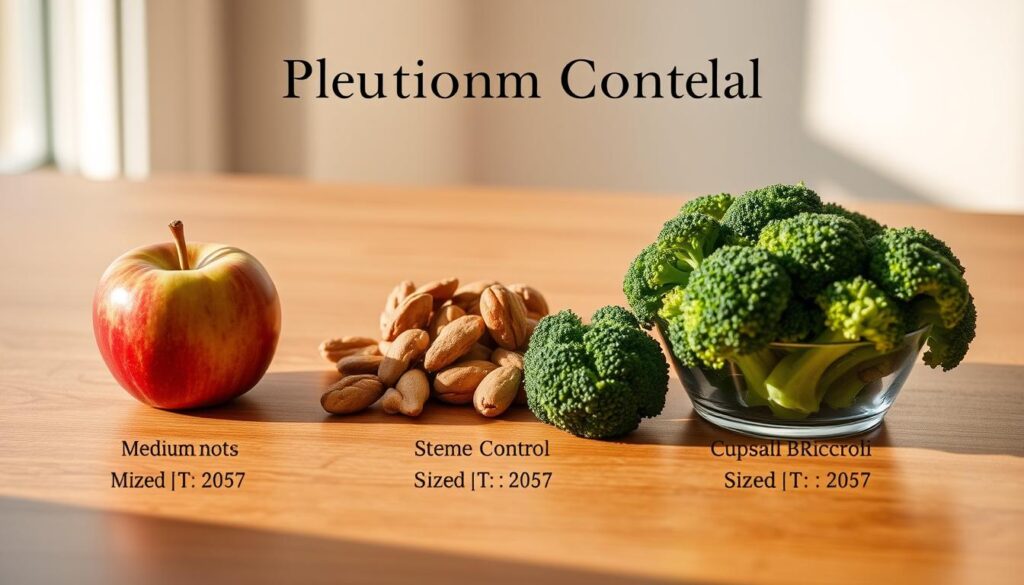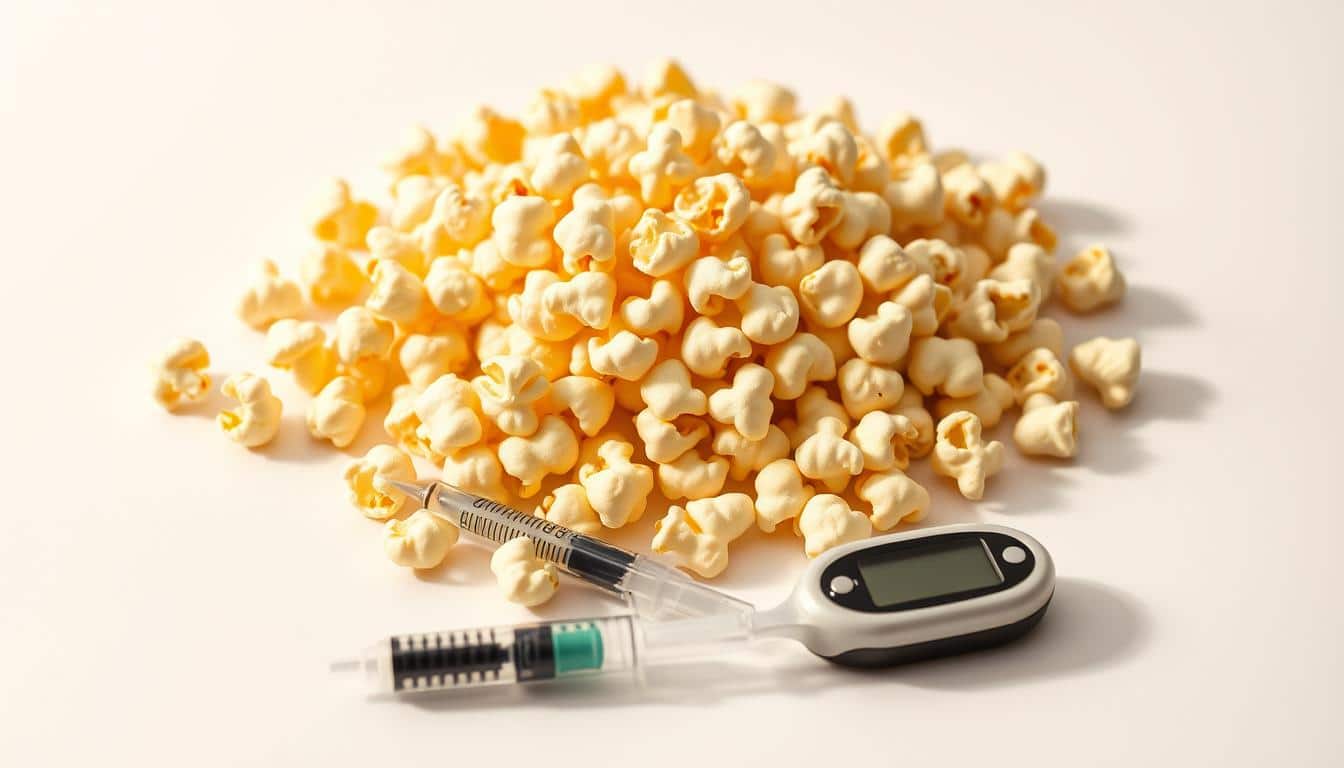Choosing snacks that align with dietary needs can feel challenging when managing blood sugar levels. Air-popped corn offers a fiber-rich option with fewer calories than many alternatives. Its composition may help stabilize glucose spikes when consumed mindfully.
Fiber plays a critical role in slowing carbohydrate absorption, which supports balanced blood sugar. A single serving contains nearly 4 grams of dietary fiber – about 15% of daily needs. Pairing this snack with protein sources like nuts enhances its nutritional profile.
Preparation methods significantly impact health benefits. Avoid butter-laden or sugary toppings that add empty calories. Stick to herbs, spices, or small amounts of healthy fats like olive oil for flavor without compromising your goals.
Portion control remains essential, as overeating even healthy carbs can affect glucose management. Measure servings instead of eating directly from large containers. This practice helps maintain consistency in your diabetes care routine.
Overview of Popcorn as a Diabetic Snack
Smart snacking plays a key role in managing diabetes effectively. When chosen wisely, certain food choices can deliver nutrients without spiking glucose. Air-popped varieties stand out for their balance of volume, crunch, and nutritional value.
Nutritional Snapshot
One cup of air-popped kernels contains just 31 calories and 6 grams of carbs. With 1 gram of fiber per serving, it slows digestion better than many processed alternatives. This combination makes it a low-energy-density option – you can enjoy more volume with fewer calories.
Medical News Today data confirms its macro profile suits controlled-carb diets. The 4:1 carb-to-fiber ratio helps moderate post-meal glucose responses. Always measure portions, as three cups still pack 18 grams of carbohydrates.
Role in a Balanced Diet
Including this crunchy snack works best when paired with protein sources like Greek yogurt or almonds. This pairing stabilizes blood sugar levels by slowing carb absorption further.
Mindful consumption means avoiding pre-flavored microwave bags loaded with salt or sugar. Instead, try nutritional yeast or smoked paprika for flavor. Sticking to single serving sizes ensures you reap benefits without overloading on carbs.
Understanding the Glycemic Index and Its Role
Managing carbohydrate intake requires understanding how different foods affect glucose levels. The glycemic index (GI) ranks carbs based on their impact on blood sugar after consumption. Low-GI options cause slower, steadier rises compared to high-GI choices.
How the Glycemic Index Affects Blood Sugar
High-GI foods like white bread digest quickly, spiking glucose rapidly. Low-GI alternatives release energy gradually, helping maintain stable levels. This distinction matters for managing diabetes, where sustained balance is crucial.
Popcorn’s GI Value Explained
Air-popped kernels score 55 on the GI scale, classifying them as low-glycemic. This means they raise blood sugar more gently than many snacks. Their high fiber content contributes to this slower digestion process.
Choosing low-index foods supports better glucose control over time. Pairing them with proteins or healthy fats enhances this effect. Always consider portion sizes to avoid excess carb intake.
Is popcorn good for diabetics: Balancing Benefits and Risks
A popular whole-grain snack offers perks but demands mindful consumption. While plain, air-popped varieties provide fiber and slow-digesting carbs, toppings like caramel or butter can turn this potential ally into a glucose-spiking foe. Research highlights that added sugars or fats negate its low-glycemic advantages, making moderation vital.
Portion control separates success from setbacks. Three cups contain 18 grams of carbs – manageable if tracked but risky if ignored. Measure your serving size beforehand to avoid mindless munching. Pairing with protein-rich almonds further stabilizes blood sugar responses.
Flavor enhancements require strategy. Instead of powdered cheese or honey, try rosemary or chili lime seasoning. These swaps add zest without compromising blood glucose targets. Studies confirm that small changes in preparation significantly impact diabetes outcomes.
Balance lies in prioritizing nutrient density over convenience. Enjoy this crunchy treat as part of a carb-conscious plan, but stay vigilant about additives. Your choices determine whether it supports or sabotages your health goals.
Nutritional Benefits: Fiber, Protein, and Whole Grains
Understanding the nutritional value of your snacks can make a significant difference in managing health goals. Whole grains like air-popped kernels deliver high fiber content while keeping calories low. This combination supports sustained energy and helps regulate appetite between meals.
Fiber-rich foods slow digestion, which stabilizes blood sugar levels after eating. Pairing them with protein sources like pumpkin seeds or roasted chickpeas enhances this effect. Together, these nutrients promote fullness and reduce cravings for less healthy options.
Vitamins, Minerals, and Antioxidants
Beyond macronutrients, whole grains provide essential vitamins such as B-complex and minerals like magnesium. USDA research highlights their antioxidant content, including polyphenols that protect cells from oxidative stress. These compounds support eye health and may lower inflammation risks.
Antioxidants in whole-grain foods also contribute to heart health and metabolic balance. Choosing snacks rich in these nutrients ensures you’re nourishing your body while managing carbohydrate intake. A focus on protein and fiber creates meals that satisfy both taste and nutritional needs.
Potential Risks and Topping Considerations
Toppings can transform a healthy snack into a dietary challenge. Many store-bought options drown air-popped kernels in butter, sugary coatings, or excessive salt. These additions undermine its natural benefits, especially for those monitoring glucose levels.
Impact of Added Sugars and Fats
Medical News Today warns that flavored varieties often qualify as ultra-processed foods. A single tablespoon of melted butter adds 100 calories and 11 grams of fats – turning a light snack into a calorie bomb. Similarly, caramel or powdered cheese mixes spike added sugar content, accelerating blood sugar spikes.
Managing Blood Sugar Spikes
Your choices determine whether this snack supports stability. Opt for plain versions or season lightly with garlic powder instead of salt. Reading labels helps avoid hidden sugars and unhealthy fats in pre-packaged bags.
Homemade air-popped batches let you control ingredients. Pair small portions with protein-rich nuts to slow carb absorption and prevent glucose spikes. Simple swaps preserve crunch without compromising your goals.
Proper Portion Sizes and Serving Guidelines
Controlling quantities plays a pivotal role in maintaining glucose stability. The USDA confirms one cup of air-popped kernels contains 31 calories and 6 grams of carbs – manageable when tracked carefully. Measuring portions prevents accidental overconsumption while delivering consistent nutrition.

Recommended Serving Sizes
Stick to 3 cups (about 18 grams of carbs) per snack session. Use measuring cups or a food scale for accuracy. Pre-portion amounts into small bowls instead of eating directly from large containers.
Carbohydrate and Calorie Management
Track daily carb limits by balancing each serving with other meals. Pair your snack with protein-rich options like roasted edamame to slow digestion. This management strategy helps avoid sudden glucose spikes while keeping energy levels steady.
Mindful eating habits extend beyond initial measurements. Avoid distractions during snack time to recognize fullness cues. Simple adjustments in serving practices create lasting benefits for blood sugar management.
Preparation Methods: Air-Popped vs. Microwave Varieties
Your cooking approach shapes a snack’s nutritional impact. Air-popped kernels and microwave bags may seem similar, but their health profiles differ dramatically. Understanding these distinctions helps you make choices aligned with glucose management goals.
Benefits of Air-Popped Popcorn
Preparing air-popped popcorn without oil keeps calories and fat minimal. USDA data shows a 3-cup serving contains under 100 calories and less than 1 gram of saturated fat. This method preserves natural fiber while avoiding additives that spike blood sugar.
What to Avoid in Microwave Options
Many microwave popcorn varieties use hydrogenated oils and excessive salt. A single bag often packs over 300 milligrams of sodium – 13% of your daily limit. Artificial butter flavorings add hidden trans fats, which Medical News Today links to heart health risks.
Stick to plain kernels popped at home for maximum control. If using microwave brands, check labels for minimal ingredients and zero added sugars. Smart preparation turns this crunchy treat into a reliable ally for balanced eating.
Comparing Popcorn with Other Diabetic-Friendly Snacks
Exploring snack options that support glucose control requires comparing nutritional profiles. The CDC and ADA highlight protein, fiber, and healthy fats as pillars of blood sugar-friendly choices. Let’s see how air-popped varieties measure against other popular picks.

Alternative Low-Glycemic Snacks
Raw veggies with hummus deliver a crunchy, protein-packed option. A half-cup of chickpeas adds 6 grams of plant-based protein and 5 grams of fiber. This combo stabilizes blood sugar better than many carb-heavy snacks.
Greek yogurt with berries offers a creamy alternative. Unsweetened varieties provide 15–20 grams of protein per serving, paired with antioxidants from fruit. This duo supports sustained energy without spiking glucose levels.
Nuts like almonds or walnuts are rich in healthy fats. A one-ounce serving contains under 6 grams of carbs, making them ideal for people diabetes. Their low glycemic impact helps maintain steady insulin responses.
Air-popped kernels hold their own with 3–4 grams of fiber per serving. While slightly higher in carbs than nuts, their volume and crunch satisfy cravings. Pairing them with a handful of seeds balances the meal for those managing type diabetes.
Choosing between these depends on your carb budget and nutritional priorities. All options fit a balanced plan when portion-controlled and paired thoughtfully.
Tips for Enhancing Flavor Without Extra Calories
Transforming plain snacks into flavorful delights doesn’t require compromising health goals. Registered dietitians recommend herbs and spices to boost taste while keeping carbs and fats in check. These options let you enjoy bold flavors without derailing blood sugar management.
Seasoning with Herbs and Spices
Swap butter for garlic powder or smoked paprika to add depth. Nutritional yeast delivers a cheesy flavor with minimal calories and extra fiber content. Cinnamon or cocoa powder offers sweetness without sugar, making it ideal for those craving dessert-like treats.
Choosing Healthy Toppings
Avoid pre-packaged coatings loaded with cheese or caramel. Instead, try lightly misted olive oil with rosemary for richness. Crushed almonds add crunch and protein, balancing the snack’s content effectively.
Experiment with chili-lime blends or turmeric for vibrant twists. These options enhance flavor profiles while preserving nutritional benefits. Remember: small changes in preparation create big differences in satisfaction and glucose control.
Expert Recommendations and Evidence from Research
Medical authorities offer clear guidance for balancing taste and health in snack choices. Following evidence-based strategies helps maintain stable blood sugar levels while enjoying satisfying foods. Leading organizations emphasize the importance of nutrient quality and portion awareness.
Insights from Medical News Today
Recent analyses confirm air-popped varieties fit well in type 2 diabetes meal plans. Their low glycemic index (55) and high fiber content align with dietary recommendations for gradual glucose release. Researchers highlight portion sizes under 3 cups to manage carb intake effectively.
Guidance from Diabetes Associations
The American Diabetes Association advises pairing whole-grain snacks with protein sources like nuts or seeds. This combination slows digestion, preventing sudden blood glucose spikes. The CDC reinforces choosing foods with minimal added sugars and sodium for long-term metabolic health.
Both organizations stress tracking daily calories and carbs when incorporating snacks. Their guidelines help those with type 1 or type 2 diabetes make informed decisions. By prioritizing research-backed practices, you can enjoy varied foods while supporting your wellness goals.
Conclusion
Navigating snack options while managing glucose requires informed decisions. Research confirms that plain, air-popped varieties can fit into a balanced diet when portion sizes stay controlled. Prioritizing fiber-rich choices helps stabilize blood sugar levels without sacrificing satisfaction.
Key strategies include measuring servings to manage carbs and avoiding toppings high in sugar or fat. Pairing this crunchy snack with protein sources enhances its nutritional impact. These habits align with evidence-based guidelines for maintaining steady blood glucose responses.
People managing diabetes benefit most when snacks complement their overall meal plan. Nutrition experts emphasize balancing carb intake with physical activity and medication. Small adjustments in preparation methods – like using herbs instead of butter – make significant differences.
Ultimately, success lies in mindful choices and consistency. Integrate smart options into your routine while tracking how they affect your blood sugar levels. With careful planning, you can enjoy satisfying snacks that support long-term health goals.
FAQ
Can air-popped varieties help manage blood sugar spikes?
Yes. Air-popped options have a low glycemic index (GI) and high fiber content, which slows glucose absorption. Pairing them with protein sources like almonds can further stabilize sugar levels.
What toppings should you avoid to keep carb counts low?
Skip caramel, butter, or powdered cheese. These add refined sugars and unhealthy fats. Instead, try spices like paprika or nutritional yeast for flavor without extra calories.
How does microwave popcorn affect blood glucose?
Many microwave brands contain trans fats, artificial flavors, or added sugars. These can spike blood sugar. Always check labels for hidden carbs and opt for plain, lightly salted versions.
What’s the ideal serving size for carb-conscious diets?
Stick to 3 cups of air-popped kernels per serving. This provides about 15g of carbs and 3g of fiber, fitting well into a balanced meal plan focused on glycemic control.
Are there healthier snack alternatives with similar benefits?
Veggie sticks with hummus, roasted chickpeas, or Greek yogurt with berries offer low-GI options. These provide protein, fiber, and essential nutrients while keeping calories in check.
Do whole grains in popcorn benefit heart health?
Absolutely. Whole grains support cardiovascular wellness by improving cholesterol levels. Combined with its antioxidant content, unsalted popcorn can be part of a heart-friendly diet.
What do experts say about including it in diabetic meal plans?
Organizations like the American Diabetes Association highlight portion control and preparation methods. Research in Medical News Today also emphasizes pairing it with healthy fats or proteins.
How does fiber content aid in glucose management?
Fiber slows digestion, preventing rapid sugar spikes. A 3-cup serving delivers 10-15% of daily fiber needs, making it a smart choice for sustained energy and blood sugar balance.


